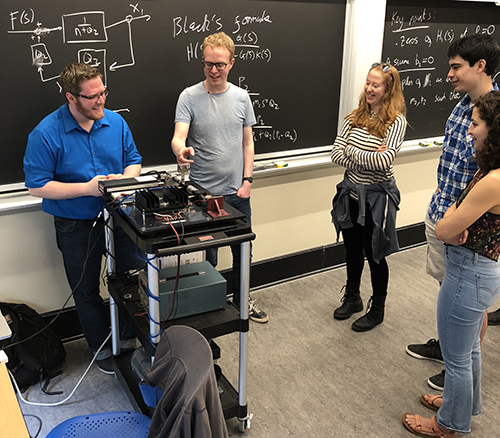Instructor Interview

Dr. Philip Pearce demonstrates a tuned mass damper, a device consisting of two coupled oscillators that is the course’s unofficial mascot. (Photo by Sarah Hansen, MIT OpenCourseWare.)
In the following video, Dr. Jennifer French, Dr. Jeremy Orloff, Prof. Haynes Miller, and Dr. Philip Pearce describe various aspects of how 18.031 System Functions and the Laplace Transform was taught in Spring 2018.
Facilitating a Blended Learning Experience
View by chapter:
- Now a Blended Learning Experience
- Using Digital Tools for Teaching and Learning
- Homework and Immediate Feedback
- Integrated Mathlets
"One of the great virtues of having online questions … is that students see right away whether they understand something or not."
Student Interview
Below, student Madeleine Schroeder reflects on her experiences in the course.
I am a first-year student and I plan to major in aerospace and astronautics. I decided to take this course because I was only taking four courses when the second half of the semester began and I wanted a little extra work to do. I have enjoyed 18.03 Differential Equations this semester and I thought it would be interesting to learn other methods of solving ODEs [ordinary differential equations] that have more accessible uses in engineering.
"Reading the lecture notes outside of class allowed me to work at my own pace."
I liked the course format as it allowed a lot of freedom in studying. Reading the lecture notes outside of class allowed me to work at my own pace, slowing down when I got confused and speeding up if I understood the material well. Having two hours of class as recitation was very helpful, as I was able to practice problem-solving methods with help present and work through concepts that I didn’t understand from the lecture notes.
My advice to other students is to take advantage of the flexibility of the course and the opportunity to work on learning material on your own. My advice to instructors is to provide more practice problems with solutions provided. These would be incredibly helpful in completing problem sets.
Assessment
Grade Breakdown
The students’ grades were based on the following activities:
- 10% Online reading/problems
- 20% Problem sets
- 20% Mid-term quiz
- 50% Final exam
Curriculum Information
Prerequisites
None, but 18.03 Differential Equations is a corequisite.
Requirements Satisfied
Unrestricted elective credits ![]()
Offered
Once or twice per year, in the fall or spring semester or in the Independent Activities Period (IAP)
Student Information
Enrollment
Sixteen students took this course when it was taught in Spring 2018.
How Student Time Was Spent
During an average week, students were expected to spend 3 hours on the course, roughly divided as follows:
In Class
Met 2 times per week for 1 hour per session; 12 sessions total; mandatory attendance.
Out of Class
Students completed online reading and practice problems before each class session.










